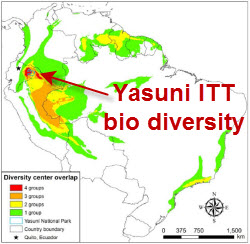Rights of Nature Tribunal
 Ecuador is one of the most biodiverse countries on the planet, with the largest number of vertebrates per square kilometer in the world . The country is among the top ten international positions by number of amphibians, birds and butterflies, and holds second place for the number of orchids ( Josse, 2001 , Hassler and Rheinheimer, 2013) .
Ecuador is one of the most biodiverse countries on the planet, with the largest number of vertebrates per square kilometer in the world . The country is among the top ten international positions by number of amphibians, birds and butterflies, and holds second place for the number of orchids ( Josse, 2001 , Hassler and Rheinheimer, 2013) .
Yasuni National Park has been considered the most biodiverse place in the Western Hemisphere . It was created in 1979 and declared a UNESCO World Biosphere Reserve in 1989. It includes 982,000 hectors in the upper Napo basin in the western Amazon. Its strategic location close to the Equator and the Andes mountain range, provides unique climatic conditions in the Amazon, with relatively uniform temperature and high humidity.
[yframe url=’http://www.youtube.com/watch?v=onldCk69p_I’]
Scientists agree the only value of the Park is for its extraordinary biodiversity, conservation status and cultural heritage. With 2,274 species of trees and shrubs, the park hosts up to 655 species in a single hectare, most of all native tree species in the United States and Canada. It has 593 species of birds and 80 species of bats, 150 amphibians and 121 reptiles and over 4,000 species of vascular plants per 1,000 km2 hectares. The number of insect species estimated at 100,000 ha, is the largest on the planet. Among these species there is a high degree of endemism.
The park has the highest density of species of amphibians, mammals , birds and plants in the Amazon. In addition , the temperature rise due to climate change will be comparatively moderate , giving it a strategic importance for the future conservation of species. These values of the Park are explained by several reasons: the stable climate , high precipitation and high and steady temperature in different seasons. The diversity of soils on firm creates various ecosystems and floodplains . It was also mentioned that the territory was a refuge during the Pleistocene. In this geological period glaciations drastically cooled the global climate, making the most of the Amazon in a meadow . Species are concentrated in few places – ” Pleistocene refugia ” – where the forest remained , as in the Yasuní , producing the speciation process or divergent evolution of new species. The Pleistocene began 2.6 million years ago and ended 12,000 years ago.
The park houses two ecosystems : the Amazon rain forest , the Amazon rain forest and floodplain (Sierra , 1999).
The Yasuni National Park is also home to two indigenous groups who have chosen voluntary isolation from Western culture : the Tagaeri and Taromenane , both belonging to the Waorani culture.
Ecuador ‘s decision to exploit the oil fields ITT Block, mostly located within the Yasuni National Park, taken from August 15, 2013 , constitutes a serious threat
